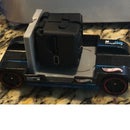Introduction: CD Rack Screen
While a little late, anyone who still has CDs in cases would appreciate this setup. It allows you to display the CDs you like most or the ones that have the most interesting album art. This could easily be adapted to store/display DVDs. This setup holds at most 84 CDs.
Step 1: Gather Materials and Tools
These instructions will be in Imperial measurements, convert to Metric as needed. Make certain to check all measurement of the cases before you begin just in case there is some difference in packaging among various regions.
Materials:
Wood - Choose wood based upon the tools you possess. 1" nominal is about as thin as you can go. As with just about everything I do, I used Home Depot super strips and planed them down to thickness. If you don't have a table saw or planer, consider furring strips your ideal choice.
Small hinges (6)
Tools:
Table Saw (Optional)
Router Table (required)
Roundover Bit
Screw Driver
Wood Glue or Polyurethane (Gorilla) Glue
Large Clamps (2' wide)
T-square
Straight Cutting Bit
Case Sizes:
DVDs 5/8" (.57" X 4-3/8" X 7-1/2")
CDs 7/16" (.41" X 5-5/8" X 4-15/16")
Materials:
Wood - Choose wood based upon the tools you possess. 1" nominal is about as thin as you can go. As with just about everything I do, I used Home Depot super strips and planed them down to thickness. If you don't have a table saw or planer, consider furring strips your ideal choice.
Small hinges (6)
Tools:
Table Saw (Optional)
Router Table (required)
Roundover Bit
Screw Driver
Wood Glue or Polyurethane (Gorilla) Glue
Large Clamps (2' wide)
T-square
Straight Cutting Bit
Case Sizes:
DVDs 5/8" (.57" X 4-3/8" X 7-1/2")
CDs 7/16" (.41" X 5-5/8" X 4-15/16")
Step 2: Design Your Rack
Your rack will need to be spaced 4-5/8" between each bar for CDs and 7-1/4" between each bar for DVDs. Decide first which you will be using, how many CDs/DVDs you'd like to hold, and how wide your bars will be.
The images for this rack are three CD's wide (roughly 18" per panel). Any more than that and the rack will become a bit unwieldy. The rack height will obviously depend how many CDs/DVDs you will want to store. This rack is just under 45" tall, it was intended to be much taller, but production problems abound.
The original design is below.
The images for this rack are three CD's wide (roughly 18" per panel). Any more than that and the rack will become a bit unwieldy. The rack height will obviously depend how many CDs/DVDs you will want to store. This rack is just under 45" tall, it was intended to be much taller, but production problems abound.
The original design is below.
Step 3: Cut, Route, Repeat
The secret to the design is very simple, but you may not have ever thought about it. The bottom of each bar is routed about twice as deeply as the top of each bar. To set the CDs in place, the CD slides up, then rotates in and sets into the top of the bar below. If the routes are too large, the CDs will rattle, too small and the CDs won't fit and you'll be spending a great deal of time sanding (provided you have assembled it).
The sides have the deeper router and the ends of each bar are shaped into tenons to fit deeply into the sides. These will be glued and clamped in place when assembled.
The cross section image has been added to remove some of the confusion the explanation may have caused.
The sides have the deeper router and the ends of each bar are shaped into tenons to fit deeply into the sides. These will be glued and clamped in place when assembled.
The cross section image has been added to remove some of the confusion the explanation may have caused.
Step 4: Glue, Check Square, Clamp
I clamped all four panels together at the same time with wax paper squares at each joint. In hindsight, this is not the best idea without any mechanical fastener (screws, brads) to hold the panels together when the glue does hold or the tenons are not as well machined as I'd like to believe.
Use plywood blanks that are sized at 4-5/8" (7-1/4" for DVDs) that can set in between the bar for squaring/gluing.
Check square after each panel is assembled, it is imperative that the bars are parallel. Rush this step and you will be sanding a great deal.
Use plywood blanks that are sized at 4-5/8" (7-1/4" for DVDs) that can set in between the bar for squaring/gluing.
Check square after each panel is assembled, it is imperative that the bars are parallel. Rush this step and you will be sanding a great deal.
Step 5: Paint, Attach Hinges and Enjoy
Prime and paint the newly glued rack. As with any project, the amount of sanding and rounding over depends largely on your preference.
My girlfriend chose spray paint in various colors with random and some "planned" shapes. The drips obviously weren't planned, but who am I to judge. At least she has a great taste in music.
The hinges should be attached to each panel to create an accordion fold. This will make the panel easier to store, and more stable.
Thanks for looking!
My girlfriend chose spray paint in various colors with random and some "planned" shapes. The drips obviously weren't planned, but who am I to judge. At least she has a great taste in music.
The hinges should be attached to each panel to create an accordion fold. This will make the panel easier to store, and more stable.
Thanks for looking!
Participated in the
The Instructables Book Contest













